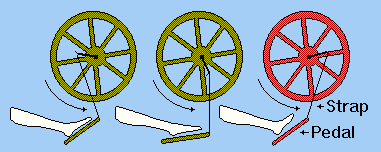
 Spinning
Spinning
Spinning a thread, a rope, or a strand of yarn involves three steps - straightening the material to be spun, putting a twist in a
thin strand of the material, and winding the twisted strand onto a bobbin.
- Material to be spun can be any fibrous material such as wool from animals, flax and cotton from plants, or silk from
silk worms. Preparing the material involves washing it, and in the case of flax, soaking and working it in water to
remove rotting soft matter from the fibers. The clean fibers are then combed straight or carded, an action where the
fibers are caught between two flat wire brushes, called cards, pulled in opposite directions.

- In the most primitive form spinning is done with a distaff and spindle, where the hand-held spindle is moved in a
circle by wrist movements and after a twist is put into the thread, is wound by hand onto the spindle. This process is
used in one form or another in primitive cultures around the world.

- The spinning wheel improves this process, allowing a foot pedal to create the spin while the hands are free to work
with the material. The foot pedal is attached by a strap to a special spoke sticking out from the center and to the side of
the wheel. When this special spoke is on the downward side of the circle, the foot gives a gentle nudge to the foot
pedal, encouraging the motion. When on the upward side of the circle, the foot releases, allowing the pedal to raise up
so as not to slow the motion of the wheel.

- There is a groove in the wheel that holds a cord, and a similar groove in a tiny wheel on the other end of the Spinning
Wheel. The relatively slow motion of the large wheel thus makes for many turns of the tiny wheel, which is attached to
the bobbin. This bobbin replaces the more primitive spindle. Enough tension is placed on the cord wrapped around the
wheel and thence to the bobbin so that the cord does not readily slip on either the wheel or the bobbin. The knot in the
cord should be as smooth as possible.

- A portion of the clean and straightened fibers are hooked onto the pointed end of the bobbin, and the turning motion
begun. The material is first drawn out gradually to a thin thread while attached to the end of the bobbin. The spinning
wheel now is giving a twist to the thread. The drawing out of the material should occur simultaneously to the twisting,
so that the twist climbs back toward the receeding hand. When the material is twisted to an arm's length, the thread is
allows to wind up along the length of the bobbin, coming back to the tip for the next thinning and twisting action.
During twisting, a slight tension holds the thread back from winding on the bobbin.

- To prevent unraveling and give added strength, the single ply thread is spun in the opposite direction, into a three ply
strand. This is done by running single threads between different fingers of the hand, skipping the twisting step and just
winding onto a large bobbin while turning the wheel in the opposite direction from the direction used to create the
single ply strands. Unraveling is prevented now because all twists are blocked by an opposing twist.

Authored by Nancy.



![]()





